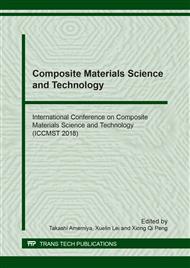[1]
A.M. Wemyss, A.G. De Boos, Effects of structure and finishing on the mechanical and dimensional properties of wool fabrics, Textile Research Journal. 61 (1991) 247-252.
DOI: 10.1177/004051759106100501
Google Scholar
[2]
S. Kawabata, M, Niwa, F. Wang, Objective hand measurement of nonwoven fabrics, Part I: development of the equation, Textile Research Journal. 64 (1994) 597-610.
DOI: 10.1177/004051759406401008
Google Scholar
[3]
H. Yokura, M. Niwa, Objective hand evaluation of non-woven used for nappies, International Journal of Clothing Science and Technology. 9(3) (1997) 207-213.
DOI: 10.1108/09556229710168333
Google Scholar
[4]
W.M. Lo, J.L. Hu, L.K. Li, Modelling a fabric drape profile, Textile Research Journal. 72 (2002) 454-463.
DOI: 10.1177/004051750207200513
Google Scholar
[5]
D.E. Breen, D.H. House, M.J. Wozney, A particle-based model for simulating the draping behaviour of woven cloth, Textile Research Journal. 64 (1994) 663-685.
DOI: 10.1177/004051759406401106
Google Scholar
[6]
B.K. Behera, S. Chand, T.G. Singh, P. Rathee, Sewability of denim, International Journal of Clothing Science and Technology. 9(2-3) (1997) 128-140.
DOI: 10.1108/09556229710168261
Google Scholar
[7]
V. Dobilaite, M. Juciene, The influence of mechanical properties of sewing threads on seam pucker, International Journal of Clothing Science and Technology. 18(5) (2006) 335-345.
DOI: 10.1108/09556220610685276
Google Scholar
[8]
G. Stylios, J. Fan, J.O. Sotomi, R. Deacon, Concept in apparel manufacture – the sewability integrated environment incorporating automated objective measurement systems, International Journal of Clothing Science and Technology. 4(5) (1992) 45-48.
DOI: 10.1108/eb003007
Google Scholar
[9]
K. Slater, The assessment of comfort, Journal of the Textile Institute, 77(3) (1986) 157-171.
Google Scholar
[10]
Y. Li, A.S.W. Wong, Clothing Biosensory Engineering. Woodhead Publishing Limited, Cambridge, (2006).
Google Scholar
[11]
G. Song, Improving Comfort in Clothing, Woodhead Publishing Limited, Cambridge, (2011).
Google Scholar
[12]
A.M. Elbadawi, J.S. Pearson, Foam Technology in Textile Finishing, Textile Institute, Manchester, (2003).
Google Scholar
[13]
A. Das, R. Alagirusamy, Science in Clothing Comfort, Woodhead Publishing India Pvt Limited, New Delhi, (2010).
Google Scholar
[14]
K.P.M. Tang, C.W. Kan, J.T. Fan, Psychological measurement of wet and clingy sensation of fabrics by the volar forearm test, Journal of Sensory Studies. 30 (2015) 329-347.
DOI: 10.1111/joss.12161
Google Scholar
[15]
K.P.M. Tang, C.W. Kan, J.T. Fan, Assessing and predicting the subjective wetness sensation of textiles: subjective and objective evaluation. Textile Research Journal. 85 (2015) 838-849.
DOI: 10.1177/0040517514555799
Google Scholar
[16]
K.P.M. Tang, K.H. Chau, C.W. Kan, J.T. Fan, Characterizing the transplanar and in-plane water transport property of fabrics under different sweat rate: forced flow water transport tester. Scientific Reports. 5 (2015) 17012.
DOI: 10.1038/srep17012
Google Scholar
[17]
K.P.M. Tang, Y.S. Wu, K.H. Chau, C.W. Kan, J.T. Fan, Characterising the transplanar and in-plane water transport of textiles with gravimetric and image analysis technique: spontaneous uptake water transport tester. Scientific Reports. 5 (2015).
DOI: 10.1038/srep09689
Google Scholar
[18]
J. Fan, L. Hunter, Engineering Apparel Fabrics and Garments, Woodhead Publishing Limited, Cambridge, (2009).
Google Scholar
[19]
C.W. Kan, C.M.C. Ko, K. Boontorn, R. Mongkholrattanasit, Wetting time measurement of fabric-foam-fabric plied material. Applied Mechanics and Materials. 866 (2017) 220-223.
DOI: 10.4028/www.scientific.net/amm.866.220
Google Scholar
[20]
C.W. Kan, C.M.C. Ko, K. Maha-in, K. Manarungwit, C. Sarikanon, P. Numahun, R. Mongkholrattanasit, Mechanical study of fabric-foam plied material. Applied Mechanics and Materials. 866 (2017) 224-232.
DOI: 10.4028/www.scientific.net/amm.866.224
Google Scholar
[21]
C.W. Kan, C.M.C. Ko, K. Ariyakuare, W. Changmuong and R. Mongkholrattanasit, "Study on air permeability and warmth retention ability of polyurethane foam plying with fabrics. Applied Mechanics and Materials. 866 (2017) 233-239.
DOI: 10.4028/www.scientific.net/amm.866.233
Google Scholar


